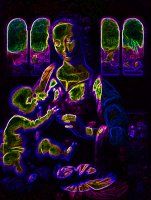
Excuse the ugly picture, but it's hard to describe schlock without an example.
Art about art (or the art world) puts me off -- it seems too incestuous, or like elitist self-congratulation -- but "schlock art" has always interested me.
What is schlock? I think it's distinguished by the serious (but clueless) intent of the artist; a clichéd theme or style; or most commonly, poor color.
Intent. I think you have to be serious about your artwork -- to believe it's deep -- to be a schlock artist. I'd call the work of Thomas Kinkade -- the celebrated "traditional values" painter/hustler -- kitsch, because it gives off the same creepy preciousness as ceramic collectibles of little dogs with fire hydrants. But he claims to be producing fine art and, hack that he is, he's convinced thousands of people to pay fine-art prices for his work, so I'll give him the benefit of the doubt and call him a "real schlock artist."
But there are hundreds of thousands of amateur artists out there, whose intentions are at least as serious as Mr. Kinkade's. I never cease to be amazed at how many people, in art classes and on their own (displayed anywhere there's an "open studios" exhibition), feel there's some reason to revisit Cubism, Impressionism, or some other art movement decades past its glory.
Part of it is just the natural search for a style, but a lot of it is willful ignorance, standing in for the unshakable conviction that marks the heroic artist in the popular imagination.
Clichéd theme or style. Again, it's shocking how many people see a future in dead art movements, ideas that tinted the world in a new way for a few moments, then evaporated. Even though the contemporary art world still depends on some intellectual heft to separate it in the public eye from its prettier sister -- the fashion industry -- at least it doesn't expect anyone outside its specialized world to believe the hype, or expect the hype to outlive the season.
But there are all kinds of romantics out there who want to believe, so they latch onto things they've seen in art books and pour their soul into painting variations on tired formulas. I'd guess that every artist goes through this stage (maybe several times), but it's the fundamentalist blindness of their belief, their refusal to break through it, that sets schlock artists apart.
Color. I think color is the real key to identifying schlock. If I had all the time in the world, I would prove it by transforming famous paintings to schlock by changing their color in Photoshop.
In fact, I just tried it; from Da Vinci's Madonna with Carnation:
First up, your basic schlock black and blue; second, I applied a filter to give it that "abstract" look, halfway between a velvet Elvis and a stained glass window.
All the synthetic pigments in paint nowadays may have something to do with bad color, but I doubt it. I think a lot of people are strangely numb to natural associations (like blue = sky) and relationships (or "color harmony") when it comes to color. So painters slather on the color of whatever tube of paint they can reach without breaking their fevered trance state, and wind up producing yet another abomination. (Of course if my theory is correct, then I should burn in hell for picking on people born with this color disability.)
So a schlockmeister is: someone who is blinded by belief and numb to color?
Then there are all the commercial galleries that sell schlock -- a large majority of all galleries. I'm not sure what the owners' motivation is beyond money, but they seem just as oblivious as schlock artists to what art can be. The art they sell just has to "look like art" to the uninitiated, and the artists they market have to "look like artists."
Anyway, I thought it would be interesting to classify the major strains of schlock. And though nearly all art magazines publish pictures of schlock, at least in their ads, no one does it like ArtNews. (I have nothing against ArtNews; it is a business, and it's not its fault that most art is schlock...) But since there's no way I'm going to scan in 50 pages of schlock, I found a digital copy of the Gallery Guide, which has at least as high a percentage of schlock.
In the image on top, I tried to include every possible type of schlock image in the Art Now New York Gallery Guide for Sept. 2000. It makes me ill just to look at the little picture, so I can't stand to wade through that Guide again to build a larger image. Just take a look at the ads in ArtNews (especially in the back) or the Gallery Guide the next time you see one.

